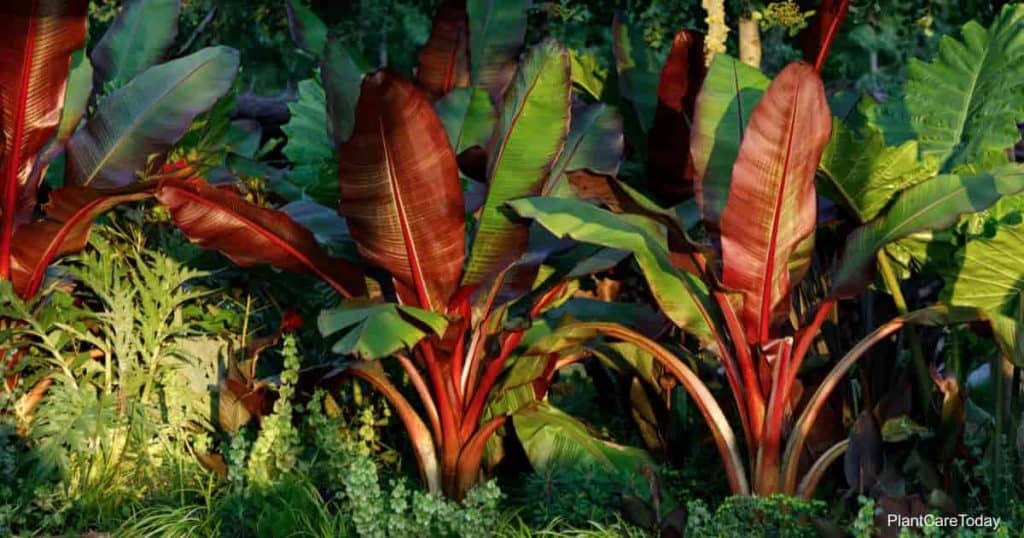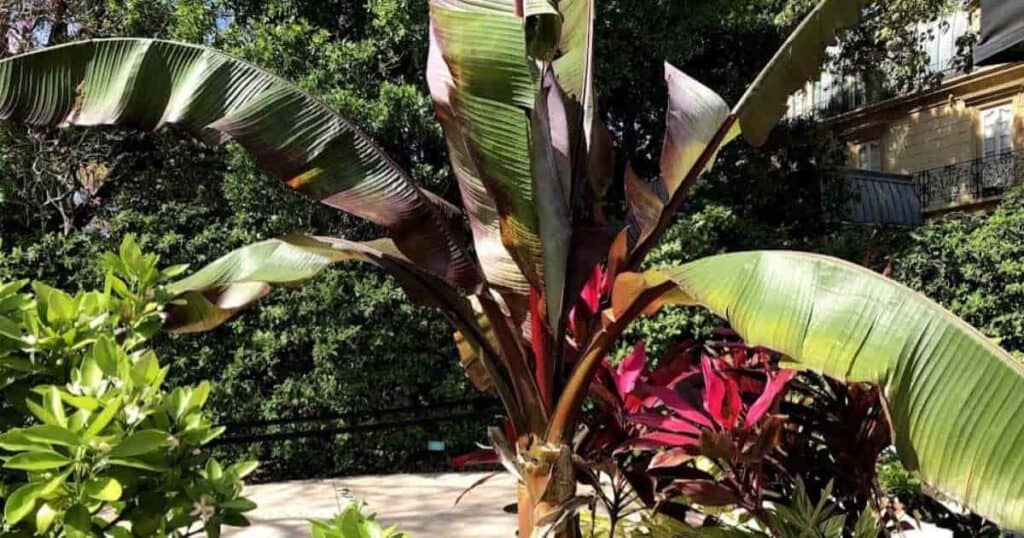Botanically known as Ensete Ventricosum [en-SET-ee, ven-tre-KO-sum], Ensete Maurelii [en-SET-ee, mor-REE-lee] is an herbaceous perennial and belongs to the flowering plant family Musaceae (banana plant).
Huge and banana-like, ensete maurellii is indigenous to East Africa.

The plant shares a resemblance to the plants in the genus Musa, where it once grew as “Musa Ensete.”
This large non-woody plant is often cultivated in Ethiopia and is a source of food for millions of Ethiopians.
The evergreen herbaceous has a few common names as follows:
- Ethiopian Banana
- Abyssinian Banana
- Red Banana
- Ensete Ventricosum Maurelii
- Red Abyssinian Banana
Ensete Maurelii Quick Care Tips
- Botanical Name: Ensete Maurelii
Common Name(s): Red Abyssinian Banana, Ethiopian Banana
Synonyms: Musa Ensete Maurelii
Family & Origin: Musaceae family, native to Ethiopia
Growability: Easy to grow
Grow Zone: USDA zones 10-11
Size: Grows up to 12-20′ feet tall and 6-10 feet wide
Flowering: Rarely flowers, but produces small purple flowers when it does
Light: Full sun to partial shade
Humidity: Prefers high humidity
Temperature: Thrives in warm temperatures, 68°F.
Soil: Well-draining soil with organic matter
Water: Keep soil consistently moist, but not waterlogged
Fertilizer: Fertilize every 2-3 weeks during growing season with a balanced fertilizer
Pests & Diseases: Susceptible to spider mites, mealybugs, and aphids. Can also be affected by root rot if overwatered.
Propagation: Propagate through division or by taking stem cuttings
Plant Uses: Ornamental plant, can be grown in containers or as a focal point in a garden.
Caring For Red Ensete Maurelii
Size and Growth
Ensete maurelii is a fast-growing banana plant with an upright growth habit, often reaching up to 12’ – 20’ feet tall in tropical areas.
When provided with ideal growing season conditions, the humungous plant may heighten up to 30’ – 40’ feet tall.
The plant usually reaches this height in its native tropical lands in temperate regions only.
The ensete leaves are usually large, paddle-like, reaching up to 10’ – 20’ feet long and 2′ – 4’ feet wide.

The foliage emerges with reddish leaf axils and maroon-red tints.
They come in an olive-green shade and have vivid midribs and prominent leaf stalks.
The foliage or leaf blade is quite dramatic, combining deep red and intense green colors.
Flowering and Fragrance
The Abyssinian banana produces non-showy white flowers during its bloom time.
However, these inflorescences are usually visible on young plants in a cool, moist season.
The plant doesn’t bloom in the first three or five years of its cultivation and evokes no scent whatsoever.
Besides this, the plant also produces dry and inedible fruiting of 3” inches long.

Light and Temperature
The tropical plant enjoys full sun or part shade to prompt active new growth.
The plant should avoid low light as it hinders growth.
For ideal formation, the plant further requires 68° degrees Fahrenheit (20° C).
During winter, the plant needs partial shade and a minimum temperature of 54° degrees Fahrenheit (12° C).
The USDA hardiness zone of Ensete maurelii is 10 to 11.
Watering and Feeding
The Abyssianian banana needs plenty of water, especially in the dry season.
The plant should not dry out between watering sessions.
The established plants are drought-resistant to some extent.

However, ensure the moist soil is well-drained, ranging from a pH level of 5.5 to 6.5.
The banana tree is a heavy feeder and therefore needs a well-balanced fertilizer. More on banana fertilizer.
During cold, chilly weather conditions, the plant does well with infrequent watering as it is dormant at the time.
Soil and Transplanting
Whether growing indoors or outdoors, the tropical plant does great in any well-draining potting soil.
The summer-loving plant is suitable for sandy, loamy, or clay soil.
Suitable pH soils are acid, neutral, and alkaline.
Pick any type of soil but make sure it is well-moist.
Generally, the ensete maurelii plant is transplanted yearly into new pots until they are finally ready to be cultivated in the field, where they stay until harvest.
The summer plant has the tendency to be transplanted multiple times, often 3 to 4 times, depending on the region it is planted.

In a scarce land, the suckers are usually transplanted into their new location, with a row spacing of 6’ to 9’ feet tall.
Grooming and Maintenance
Avoid overwintering at all costs. In winter, bring the plant indoors to protect it from heavy snow and strong winds.
Place it into a conservatory or frost-free location to keep it in the best possible state.
However, some species of the plant may sustain light frost, but it’s recommended to bring the plant inside before the first frost.
The banana plant may need light pruning. Simply remove old leaves from the base with the help of a scissor or a knife, especially for container plants.
How to Propagate Abyssinian Red Banana
The propagation of the heat-loving plant is performed by dividing the plant, sowing seeds, or tissue culture.
Botanists suggest seeding is the best propagating method as the plant species don’t produce suckers.
Before sowing, the seeds need to soak in warm water for a day before the sowing lightly.
Plant the seeds deep in a semi-warm location.
The fresh seeds are quick to germinate, while the older ones take approximately six months.

To encourage growth, water the soil more frequently and keep the specimen in a sheltered area.
Red Abyssinian Banana Pests and Diseases
Some major threats to Ensete maurelii are bacterial diseases such as:
- Corm rot
- Dead heartleaf rot
- Sheath rot
- Bacterial wilt
And viral diseases, including:
- Mosiac virus
- Anthracnose
- Toot lesion
- Toot-knot
- Chlorotic leaf streaks
Fly spiders, spider mites, jassids, aphids, and mealybugs hinder the growth of the houseplant.
Ensete Maurelii Uses
These foliage plants have several edible and medicinal uses.

The sheath of the green leaves is used in making a type of flour known as “kocho,” from which good-quality bread is made.
The seed’s endosperm is also edible and hence ideal for cooking purposes.
The trunk-sized leaves and stems are often used for treating liver problems and side effects of miscarriage, while the infusion of leaves and fruits is employed for curing hepatitis.
In addition, the Abyssinian Banana makes an excellent evergreen perennial that adds an exotic and tropical flair to your landscape.
